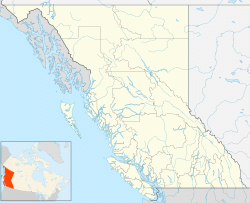Salmon Arm

Salmon Arm is a city in the Columbia Shuswap Regional District of the Southern Interior of the Canadian province of British Columbia that has a population of 17,706 (2016). Salmon Arm became a city on May 15, 1905 and is now the location of the head offices of the Columbia-Shuswap Regional District. It is a tourist town in the summer, with many beaches, camping facilities and house boat rentals. Salmon Arm is home to the longest freshwater wooden wharf in North America.[2]
Salmon Arm takes its name from its place along Shuswap Lake. The lake has four “arms”: Shuswap Arm in the west, Seymour Arm in the north, Anstey Arm in the northeast, and Salmon Arm in the south, named after the large runs of salmon that used to run up the creeks that empty into the lake. The city of Salmon Arm takes its name from its location along the Salmon Arm of Shuswap Lake.[3]
Salmon Arm is located within the traditional territory of the Secwépemc.[4] Much has been written about the history of Salmon Arm following the laying of the Canadian Pacific Railway in September, 1885. While miners and settlers looked for gold in the surrounding areas, the beaches of Salmon Arm lay virtually untouched. By the end of the 1890s, the town had grown to include many new buildings such as two general stores, a school, and a hotel. The population had also grown to include over 200 citizens.
By 1904, Salmon Arm had acquired a reputation for having an excellent fruit harvest. The local businessmen grew fruit as a main export, sending it to the larger, more populated towns that surrounded it.
In May 1905, a formal local government was started by the request of its citizens. Later on, in 1912, Salmon Arm upgraded its town status to an official city.
In 1951, Princess Elizabeth, Duchess of Edinburgh and Prince Philip, Duke of Edinburgh visited Salmon Arm while on a royal tour of Canada.
On August 8, 1982, while Prime Minister Pierre Elliott Trudeau and his sons passed through Salmon Arm, they were confronted by three demonstrators protesting “high unemployment and the way the Prime Minister was handling the economy.”[5] Trudeau infamously gave the protesters the finger; his gesture was caught on a single television camera and immediately used by some as, “a vivid symbol for those who thought the Liberal prime minister arrogant and hostile to Western Canada.”[6] However, to many Trudeau’s response was seen as a commemorated joke. Only a month after the incident T-shirts, which depicted a caricature of Trudeau leaning out of a train with his middle finger raised, were being produced and sold to the citizens of Salmon Arm.[5]
In 1998, an area of 13,500 acres (34 km2 or just over 5000 hectares) immediately southwest of Salmon Arm was burnt to the extent of deforestation by a wildfire started by lightning. An emergency evacuation was executed as the fire got closer. Remarkably, just as the fire reached the valley floor, a sudden change of wind direction forced the fire back on itself, extinguishing it. The fire came so close that trees in many backyards were singed and barn paint was peeled. The media reported “20 homes and 15 barns”[7] were destroyed during the firestorm in the Silver Creek area to the south of Salmon Arm, which also produced Canada’s largest civil evacuation up to that date when the “5,000-hectare forest fire that forced the removal of 7,000 residents of Salmon Arm was being blown toward the town.”[8]
